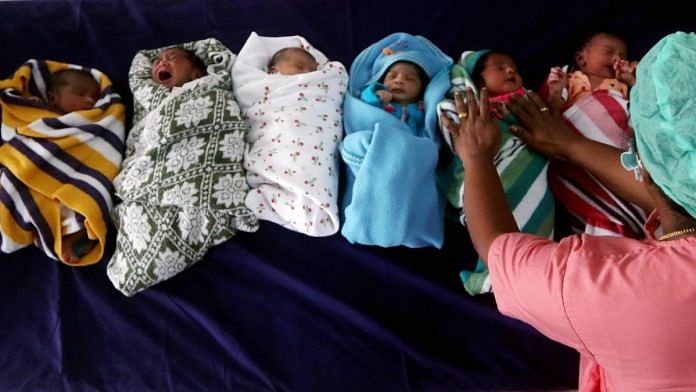New Delhi: Mizoram, Nagaland, Sikkim, and Manipur are among the states that rank the highest when it comes to infant mortality rate (IMR) in India, according to the latest (2019) data released by the Sample Registration System (SRS). However, fellow Northeastern state Assam fares among the worst.
The SRS, overseen by the Office of the Registrar General & Census Commissioner, is a key repository of data on birth rate, death rate, and infant mortality rate, among other population-related parameters. Its latest bulletin was released last week.
IMR records deaths of infants below 1 year per 1,000 live births. It is a key yardstick to determine the larger health situation of an area. According to the World Health Organization (WHO), infant mortality rates “reflect the social, economic and environmental conditions in which children (and others in society) live, including their health care”.
Across India, Madhya Pradesh (46), Uttar Pradesh (41), Assam (40) and Chhattisgarh (40) have the highest IMR, while the lowest has been registered in Mizoram (3), Nagaland (3), Sikkim (5) and Kerala (6).
ThePrint mapped SRS data for the Northeast from 2015 to 2019 and found that Mizoram has been one of the best performing states, with the IMR falling to 3 from 32. This means that against 32 infant deaths per 1,000 live births in 2015, the state recorded three in 2019.
Dr Lily Chhakchhuak, head of the Reproductive and Child Health (RCH) division of the Mizoram health department, described this as a multi-department effort, and said the state government has tried to equip as many facilities and train as many personnel as possible.
“We also have these sub-centres and health and wellness centres with trained personnel. Even during Covid, delivery was being conducted in most of our sub-centres and the state government has tried to equip even centres which have not been identified as delivery points… So the facilities are easily accessible,” she added.
Mizo culture, she said, has also played an important role. “We generally don’t have as much of a gender bias, so women are taken care of during pregnancy… Because of the [high] literacy levels, it is easier to educate and mothers are very conscious on the whole. The whole family also remains concerned when the baby falls ill,” she added. “Even if a child or maternal death occurs, everyone will question us and the programme officer. There is awareness.”
Nagaland’s IMR of 3 in 2019 also marks big progress since 2015, when it was 12.
Sikkim is another state that has made giant strides with respect to IMR. Its ratio was 5 in 2019, as against 18 in 2015. The IMR in Manipur climbed to 10 in 2019, from 9 in 2015.
Also Read: Drones start Covid vaccines delivery in Northeast, make first drop in Manipur
Worst-performing states
Assam is among the worst-performing states in the entire country, with an IMR of 40 — way above the national average of 30. However, this number is an improvement over 2015, when the state’s IMR was 47.
Assam’s National Health Mission director Lakshmanan S. said the health department is looking into data from the Hospital Management System, since there “would be a variation” with the survey data.
“That is a survey report; in a survey, a lot of estimations happen, so they have written certain base figures. There are standard, statistical practices, how to project it for the whole state… They did not go to each and every location or home where a child and a mother has died,” he said.
“What we are trying to do is identify each and every location where infant mortality is recorded, and trying to work out what is the defect, if it is there. Whether it is an issue of human resources, infrastructure or referral. We are trying to strengthen those points,” added Lakshmanan.
The IMR in Meghalaya is also above the national average, at 33. Even so, this marks a decline as compared to 2015, when it was 40.
Asked about the high IMR, Ram Kumar, Meghalaya Joint Secretary (Health) & Director of the National Health Mission (NHM) in the state, said efforts are under way to address it.
“The average mother in Meghalaya is carrying the fourth child at any given point of time, whereas the average Indian woman may not even be carrying their second. The problem… is the gap between children is very, very less. When the gap is very less… the mother’s health will be severely affected… that affects the children, the child’s growth, and the mother’s attention to children also.”
He added that the health department is taking active steps towards curbing anaemia among women — also a rampant problem — besides ensuring safe delivery, and the “right to birth spacing”, i.e. the time from one child’s birth until the next pregnancy. The measures, he said, have heralded results.
“From last September to this September, we’ve seen a 30 per cent reduction in infant deaths. An over 20-25 per cent reduction in maternal deaths, this has been consistent,” he added.
Tripura’s IMR of 21 marks an uptick over 20 in 2015.
(Edited by Sunanda Ranjan)
Also Read: India sees high number of skin cancer cases in north, northeast regions, ICMR study finds



